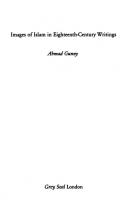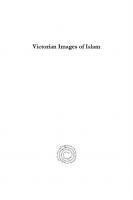Images of Islam in Eighteenth-Century Writings 1856400352, 9781856400350
217 41 6MB
English Pages 212 [220] Year 1996
Contents
Preface
Introduction
1 The Middle East as seen by some travellers, diplomats and Roman Catholic missionaries
2 Scholars in Middle Eastern languages and Islam
3 Protestant views of Islam from Abbadie to Gagnier
4 Islam in French clandestine texts
5 Images of Islam in Letters writ by a Turkish Spy and Lettres persanes
6 Islam in French Enlightenment polemical writings
7 Islam in some other French and English writings 1741-1798
Conclusion
Bibliography
Index
Recommend Papers

- Author / Uploaded
- Ahmad Gunny
File loading please wait...
Citation preview
Images o f Islam in Eighteenth-Century Writings
Images o f Islam in Eighteenth-Century W ritings
A hm ad Gunny
G rey Seal
London
First published 1996 by Grey Seal (Publishing) Limited 28 Burgoyne Road, London N4 1AD, England © Ahmad Gunny 1996 All rights reserved. No part o f this publication may be reproduced or transmitted in any form or by any means, electronic or mechanical, including photocopy, recording or any information storage or retrieval system, without permission in writing from the publishers or their appointed agents. B ritish Library Cataloguing in Publication Data Gunny, Ahmad Images o f Islam in Eighteenth-century Writings I. Tide 297 ISBN 1-856404)35-2
TheAuthor. Born in Mauritius and brought up a Muslim, Ahmad Gunny entered the Mauritius Civil Service and served in the High Commission, London, as Second Secretary. He was later appointed First Secretary. He earned his first B A in English, history and geography at the University o f Leeds, his second in French at the Univer sity o f London, where he later was awarded a Ph.D. in French. He also took a Di ploma in Education at the University o f Oxford. He is Senior Lecturer in French at Liverpool University and has published in Studies on Voltaire, Dix-huitième tiède, Freuds Studies, the British Journal for Eighteenth Century Studies and the Journal o f Islamic Studies. In 1979 he published his first book, Voltaire and English Literature: A Study of English Literary Influences on Voltaire.
C ontents
Preface
vii
Introduction
1
1 The Middle East as seen by some travellers, diplomats and Roman Catholic missionaries
9
2 Scholars in Middle Eastern languages and Islam, 1672-1718
37
3 Protestant views o f Islam from Abbadie to Gagnier
65
4 Islam in French clandestine texts
84
5 Images o f Islam in Letters writ ly a Turkish S/y and Ldtmpenatus
106
6 Islam in French Enlightenment polemical writings
130
7 Islam in some other French and English writings, 1741-1798
170
Conclusion
193
Bibliography
197
Index
206
Preface
Some yean ago when I published a paper on Islam in the Lettres persanes, I was encouraged by the response o f scholars in Britain and France who urged me to con tinue the investigation over a longer period. In the following pages I attempt to fol low their suggestion. My thanks are due to French-speaking academics such as Mme Denise Brahimi o f the Université de Paris VII, Mlle Marie-Hélène Cotoni o f the U nivenité de Nice and Michel Bastiaensen o f the Univenité libre de Bruxelles. The late Robert Shackleton, M anhal Foch Professor o f French Literature in the University o f Oxford, made valuable suggestions about the lines o f enquiry I could follow and convinced me that Islam is a very good subject to work on. I often found inspiration in the work o f Montgomery Watt, Emeritus Professor o f Arabic and Islamic Studies, University o f Edinburgh, and I am also grateful to Dr Nooh AlKaddo for his assistance. Islam is an emotive subject which certainly requires the dispassionate judgement o f scholars. There might also be some advantage in being able to see it both from the inside and outside, provided one has broad sympathies and a deep interest in i t Responses to Islam in the West have been going on for more than thirteen hundred years and will no doubt continue. I have therefore had to set limits to the investiga tion, both chronological and geographical. I hope these will not seem arbitrary. Although primarily interested in assessing French reactions, I also examine those o f other European writers, particularly the English, since these reactions are somehow connected. My work has been facilitated by periods o f study leave obtained from the University o f Liverpool and by the award o f research grants from the British Academy. I thank both institutions. I also wish to thank the Voltaire Foundation, Oxford, and the editor o f French Studies for permission to use material from my articles published by them. The advice given by the Oxford Centre for Islamic Studies, St Cross College, is much appreciated.
Introduction
In the modem period, the politics o f the Middle East seem to attract as much world attention as the main religion o f the area, Islam. In the Middle Ages, the religious factor was more significant and an altogether different picture o f Islam emerges. Dur ing the Crusades, Islam is, o f course, perceived as the arch-enemy o f Christendom. Then—as they continue to be much later—Muslims are infidels, (though the epithet 'infidel' is also used by Muslims to denigrate Christians). In medieval epic poetry, Muslims, despite the fact that their distinguishing feature has always been a strict ad herence to Unitarian beliefs, are often described as pagans.1 One may, therefore, legit imately ask whether there was ever a period when the West held a balanced view o f Islam and its Prophet and was seriously interested in them. The chance for a bal anced appraisal appears greater in the interval that stretches from the seventeenth to the eighteenth century. O r is this a pious hope, since responses to Islam are often dependent on the past as well as having a continuing tradition? Many writers were no doubt still imprisoned by the 'stereotypes* o f an earlier age, but to think this is true o f all Europeans o f the seventeenth and eighteenth centuries is to deny them a capacity for intellectual development W hat o f the subsequent period? While it is clear that Romantic poets such as Lamartine portray Islam with some understanding, much o f the nineteenth century is too steeped in colonialism to be fair to i t 21*Even the late eighteenth century is not immune to imperialist designs. Indeed, for some years, the Ottoman Empire and Islam suffered from a threat o f intervention by European powers. This period culmi nated in Napoleon’s expedition to Egypt in 1798, carried out with a body o f scien tists, scholars and officials who planned to turn Egypt into a French colony while liberating it from the Ottomans. Still, Islamic communities are generally viewed with less discredit in the age o f the Enlightenment than they are by anthropologists after wards. If Buffon assumed the superiority o f European nations on the basis o f skin colour, it is rare to find specifically racist remarks about the Arabs among his con temporaries. Indeed, the Arabs do well in the more systematic racial classification made in 1775, in Dt generis bumani varietate nativa by the German Blumenbach, who assimilates all o f them to the European variety. But by 1830, they had been demoted. In the Histoire naturelle du genre humain (1802) o f J.J. Virey, the Turks, Persians and ancient Egyptians have become part o f the second race, while the third now includes the 'hordes arabes*, the Moors and the Barbaresques. In L'Homme Essai zoologique sur U genre Immain (1827), Bory de Saint-Vincent puts the Arabs in second place after Europeans who are superior.2 To crown it all, the image o f sensuality and sex oozing from the languid odalisque becomes fixed in nineteenth-century a rt 1 In the Charroi de Ntmes, for instance, the paean Saracens worshipped M ahomet and Tervagan. See also Paul Bancourt, Les Musulmans dam les ebansom de geste du









